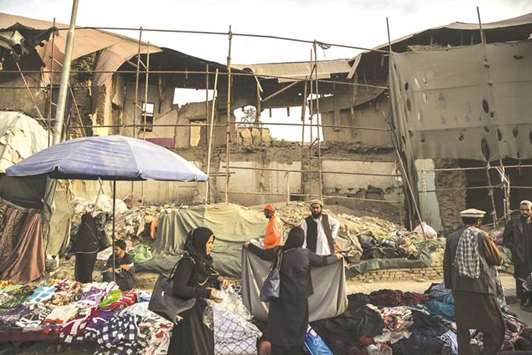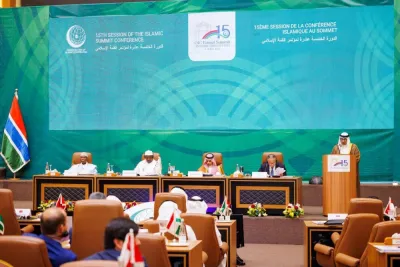As Islamic finance makes its way into mainstream banking in Afghanistan, hopes are high that Shariah-compliant banking will provide a much-needed momentum for the country’s economy after decades of war, unrest and political instability and provide much-needed capital to rebuild the demolished infrastructure.
Afghanistan’s commercial banking system is still in a fragile state and only slowly adapting to international standards. After the Taliban rule ended in 2001, the entire sector was left devastated and banks had ceased all lending activities, which had moved into the informal sector and largely remained there in form of the hawala system.
Only with the help of the international community, the commercial banking sector came somehow on its feet in the following decades, at least in the larger cities, while the vast majority of the rural population is still unbanked with only a small percentage of Afghans currently holding bank deposits. Estimations are that currently only 5.7% of the population has dealings with the banking sector at all.
As of 2018, the country had a central bank, three state banks and about a dozen private financial institutions, three of them foreign (Pakistan), and around 400 bank branches, most of them in urban centres. Thus, banking remains highly centralised, with 75% of all loans made in Kabul Province.
For businesses and entrepreneurs, there are still huge obstacles for accessing credit through banks and other formal financial institutions which entrenches dependence on the informal credit market or on family assets. Afghanistan still has a no public debt market to speak of, which increases difficulties to finance public projects and infrastructure.
Apart from an undersupply in banking services, another reason that the vast majority of the 30-mn-population shuns commercial banks is that they seek to avoid interest-based finance for religious reasons. But even though some banks have opened Islamic windows – among them Afghan United Bank, Ghazanfar Bank and Afghanistan International Bank – products and outreach are limited.
However, with the new approach towards Islamic finance things could change. Afghanistan’s central bank, Da Afghanistan Bank, issued a regulatory framework for Islamic banking in 2015 in a move to strengthen Islamic banking by setting clear legal standards with rules based on Bahrain-based Accounting and Auditing Organization for Islamic Financial Institutions, a major standard-setting institution in the Islamic finance industry.
Furthermore, this April, Afghanistan’s central bank granted a licence to the Islamic Bank of Afghanistan (IBA), the first lender in the country to apply the interest-free principles of Islamic finance in all its operations. The IBA had paid-up capital of $25mn, held $187mn of deposits as of end-2017 and operates a network of 59 branches across the country, the third-largest. Since January, the bank has been converting its assets to meet Shariah-compliance and has begun offering basic Islamic finance products such as mudaraba (investment partnership) and ijara (leasing contract).
IBA also plans to introduce wealth management products and announced to launch new digital banking services in the coming months.
This adaption of Islamic finance in Afghanistan is seen as a big leap towards the development of a larger Islamic finance sector, which could motivate other lenders to convert their assets too in a country whose population is 99% Muslim, highlighting the importance of Islamic banking availability for the majority of Afghan nationals as there remains huge unmet demand for a large variety of Islamic financial services, not only for individuals, but also for businesses – including SME and microfinance – and the public sector.
“Islamic banking went off with a good start,” said Abdul Jabbar Safi, chairman Afghanistan Industrial Association at recent industry conference organised by the Afghanistan Chamber of Commerce and Industries in Kabul to promote awareness for Islamic finance and provide a platform to the members of business community.
“However, it is vital that Islamic banking in Afghanistan expands its product base, financing capabilities and ensures that the trust of the depositors and customers is strengthened for further growth of the banking as well as the industrial sector of the country,” he added.
Meanwhile, the Afghan government also pledged to improve the situation.
“We are aware that the majority of industrialists and businesspersons in Afghanistan restrain from engaging with banks for their financial needs, largely due to the prohibition of riba,” said Kamila Siddiqi, Deputy Minister of Commerce and Industries.
“A workable model of Islamic banking certainly has the potential to bring businesses to banking channels, thus strengthening the overall economy,” she added and recommended more banks in the country look into Shariah compliance in order to boost Islamic banking and also entice people to save their money in these banks.
In the public sector, the International Monetary Fund (IMF) is currently assisting Afghanistan in preparing the issuance of sukuk. While the country’s authorities are working on the legislative infrastructure, the IMF is advising on a sukuk implementation roadmap, including identification of assets to back sukuk and preparing the necessary capital market and securities issuance legislation and regulations.
“This will be an effective tool to boost the economy of Afghanistan and restore public confidence in Afghanistan’s economic policies as well,” said Alam Khan Hamdard, sukuk adviser to the Afghani Ministry of Finance.
“It could raise billions to finance infrastructure projects, which in turn would create hundred thousands of jobs, as well as increase the per capita income and raise GDP. It would also provide efficient long-term financial instruments to the government to stabilise the financial system and support the monetary policy of the nation,” he added.

Shoppers browse merchandise at open air markets in Kabul, Afghanistan, in this file photo dated November 5, 2017. Afghanistan’s central bank, Da Afghanistan Bank, issued a regulatory framework for Islamic banking in 2015 in a move to strengthen Islamic banking by setting clear legal standards with rules.


